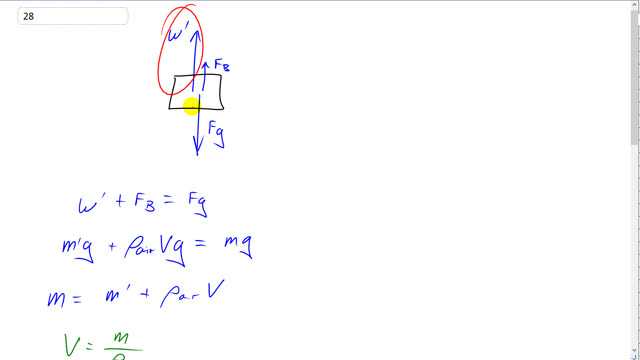
Calculate the true mass (in vacuum) of a piece of aluminum whose apparent mass is 4.0000 kg when weighed in air.

In order to watch this solution you need to have a subscription.
This is Giancoli Answers with Mr. Dychko. When this aluminum block is measured in air, it's apparent weight is acting upwards this is the force due to the spring scale or maybe due to some platform scale that's pushing upwards that's W prime—apparent weight— and that's added to the buoyant force due to the weight of the air displaced and those together equal the force of gravity downwards. So normally, we neglect the buoyant force when we are dealing with air because it's really small but since we have this mass of this aluminum block, the apparent mass measured to four decimal places of precision, in that case, the buoyant force due to air will be significant. So we have W prime plus buoyant force upwards equal force of gravity down and the buoyant force up is the apparent mass up which we know times g, that's m primeg plus the density of air times the volume of air displaced which is the volume of the piece of metal times g—this is the mass of air times g to get the buoyant force. In other words that whole term is the weight of the air displaced and Archimedes principle says that the buoyant force upwards due to a fluid is equal to the weight of the fluid displaced and this equals the true mass of the aluminum block times g downwards. And the g's cancel and we have true mass is apparent mass plus density of air times the air's volume. So the volume of air displaced is is the true mass of the aluminum divided by the aluminum's density. And then we can substitute that in for volume and then bring this term to the left hand side by subtracting it from both sides. So we have m minus m times density air divided by density aluminum equals m prime and then factor out the m here and then divide both sides by this bracket and you get the true mass is the apparent mass divided by 1 minus density of air divided by density of aluminum. Now since the density of air is small and the density of aluminum is big, this ratio is gonna be small and so usually when you go any apparent mass divided by 1 minus the small number, it's still just the same as dividing by 1 but here we have four units of... four decimal places of precision. So it turns out that it is significant and we get 4.0019 kilograms is the true mass of this aluminum.